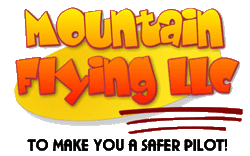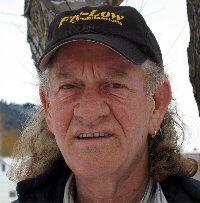 STALLS
REVISITED
STALLS
REVISITED
By Sparky Imeson
The term “threatened and endangered” is used to describe small airports that are disappearing throughout the U.S. at an alarming rate. It might also be appropriate to add this label to pilots who have not been exposed to stall aerodynamics.
Many pilots avoid stalls because they encompass the unknown. During my primary flight training I would go out one day to practice stalls and the airplane would rotate to the left or the right and only occasionally did it fall through the horizon with the wings level. I didn't know what was going on, only that this stall practice encompassed the unknown. We all fear the unknown. Because the stalls were not predictable, they created fear. Read on and you can eliminate this fear.
So what is this magic information about stall aerodynamics that eliminates the fear of stalls?
Stall Aerodynamics
Anyone preparing to take the FAA Private Pilot written exam in the last 40 years or so has been exposed to the fact that “an airplane can be stalled at any airspeed and any attitude.” This is mostly true, but the “any airspeed” might be an exaggeration. At high speeds, an excessive load factor will be encountered when pulling back on the control wheel before reaching the critical angle of attack where the airplane will stall. This high g-loading leads to structure failure before the stall is reached. But, assuming the airplane doesn’t break and also assuming that the pilot is physically strong enough to pull back sufficiently to exceed the critical angle of attack, then the airplane will stall … even when flying straight down toward the ground.
Another basic aerodynamic fact that everyone has been exposed to includes the fact that the airplane creates a relative wind when it flies. This “wind” is parallel and opposite to the flight path. It is essential to keep in mind that the relative wind that approaches the airplane during a slip or a skid does so at an angle, paralleling the flight path. If the airplane is in a slip it has some movement toward the inside of the turn rather than along the longitudinal axis of the plane. During a skid the airplane moves toward the outside of the turn, causing the relative wind to strike the fuselage at an angle.
It’s easy to prove this. Try some slips and skids at ground
reference maneuver altitude, maybe 600- to 800-feet AGL. You can see
the airplane move toward the inside of the turn during a slip and
you will notice that the airplane flies toward the ball of the
turn-and-bank indicator (turn coordinator). You will also see and
feel the plane move to the outside of the turn during a skid, and
again the airplane flies toward the ball.
The scary part of stalls has to do with the forces encountered during a climb, especially power-on climbs.
Forces
There are four forces that affect the airplane during a power-on climb. Right rudder is required to compensate for torque, p-factor, gyroscopic precession of the propeller, and the corkscrewing effect of the propeller slipstream.
The corkscrewing effect of the propeller slipstream results in a spiraling mass of air being directed rearward. This air strikes the left side of the airplane. If its arc is large enough to miss the left side it also misses the right side, so the effect is concentrated on the left side, especially the vertical stabilizer and rudder.
Stalls
If the airplane is stalled during a power-on climb with the feet off the rudder pedals, we know the ball is to the right of the index on the turn coordinator because of the left-turning forces. This means the airplane’s flight path is to the right and the relative wind strikes the fuselage at an angle from the right. This blocks some of the airflow to the left wing. When the stall occurs, the airplane rotates to the left. I’m always cautious in picking my terms while explaining this to students. They don’t really appreciate it if I say, “Now watch this, the left wing is going to fall off.”
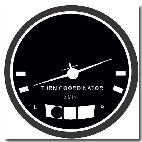 If
too much rudder pressure is applied during the climb the ball moves
to the left of the index. The airplane is in a slipping left turn
where the needle and the ball of the turn coordinator are to the
left. The airplane is flying toward the ball, the relative wind
strikes the fuselage from an angle along the left side of the
airplane. The fuselage will block a portion of the airflow to the
right wing so that when a stall occurs the right wing will stall
first. The causes the airplane to rotate to the right during the
stall. Notice the airplane always rotates away from the ball. It
doesn’t matter whether it is a slip or a skid.
If
too much rudder pressure is applied during the climb the ball moves
to the left of the index. The airplane is in a slipping left turn
where the needle and the ball of the turn coordinator are to the
left. The airplane is flying toward the ball, the relative wind
strikes the fuselage from an angle along the left side of the
airplane. The fuselage will block a portion of the airflow to the
right wing so that when a stall occurs the right wing will stall
first. The causes the airplane to rotate to the right during the
stall. Notice the airplane always rotates away from the ball. It
doesn’t matter whether it is a slip or a skid.
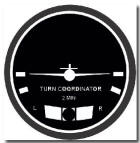 We
still don’t have enough information to make stalls predictable. What
if the ball is kept exactly centered, coordinated flight, during the
climb? This is where the scary part of stalls comes into play.
During the stall the darn airplane falls to the right.
We
still don’t have enough information to make stalls predictable. What
if the ball is kept exactly centered, coordinated flight, during the
climb? This is where the scary part of stalls comes into play.
During the stall the darn airplane falls to the right.
It doesn’t make sense. Well, maybe it does.
We mentioned that the corkscrewing effect of the propeller slipstream is concentrated on the left side of the airplane. Wind tunnel tests show that this force begins moving up on the vertical stabilizer as the angle of attack is increased. The force nearly disappears when the critical angle of attack is reached. So we are applying right rudder to compensate for a force that disappears at the stall and this causes rotation to the right during the stall when the airplane is flown in coordinated flight.
Non-Scary Stalls
If it
is desired to practice stalls and have the nose of the airplane fall
through the horizon with the wings maintaining a level attitude,
relax the right rudder somewhat during the power-on stall. The
amount that you relax the rudder pressure, or push on the left
rudder, is that which causes the ball of the turn coordinator to be
about one-half to three quarters of the way out of the index to the
right.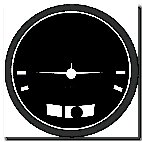
Spins
A spin is defined as an aggravated stall that results in autorotation with a corkscrew path downward. Discussions during hangar flying sessions or even newspaper reports can cause a pilot to develop an unconscious aversion to spins.
The stall/spin accident is aviation’s #2 killer of general aviation pilots. This is in part because during training the modern airplane has to be forced to spin and it requires considerable judgment and technique to get the spin started when loaded with the student and his instructor. However, when a passenger or baggage is added to the back, this same airplane may be put into an accidental spin with surprising ease.
Spin avoidance is a matter of practicing cross-control stalls until a conditioned reflex of using the rudder is ingrained. During a power-on stall where the wing falls to the left or right, the pilot who has not developed the conditioned reflex of using the rudder will instinctively apply aileron to stop the roll. Modern airplanes, those built since the late 1940’s, are required to have aileron control during a stall. This control is not sufficient to stop the roll without the addition of rudder. In fact, when the airplane rolls to the left and right aileron is used to counter it, the left aileron is deflected downward to increase lift on the left wing. Lift and drag are directly proportional, so the increased drag resulting from the increased lift may actually aggravate the problem.
If, instead of aileron, the rudder is used to “pick up” the wing, the airplane will not spin. To set up the autorotation required to develop a spin the nose of the airplane must turn or yaw at least 90 degrees. Rudder will stop the turn and prevent the spin.
I have trained more than 2,000 primary students and each one performed a spin prior to their first solo. It’s not good for business to scare a student. They quit training and quit spending money. So it is necessary to present the spin in a non-scary way.
Rudder, Rudder, Rudder
To make spin training enjoyable … actually the avoidance of spins … a detailed explanation of stall aerodynamics preceded the practice of cross-control stalls. These were gentle stalls conducted while climbing with partial power and the ball of the turn coordinator to the right of the index. The student expected the airplane to roll left, and it did. The student was allowed to use only the rudder and elevator to recover from the stall (initially the instructor held the ailerons so they could not be moved). This established the use of rudder as a conditioned reflex as opposed to instinct. The student continued practicing cross-control stalls during dual lessons before solo. The instructor gradually used more power to create a faster rotation of the airplane during the stall and asked the student to delay the recovery allowing the airplane to roll further and the nose to pitch down further.
Notice that during this training the instructor is not flying the airplane, he does not demonstrate a spin, and he does not mention the word “spin.” Eventually, as the student becomes relaxed with the maneuver, the recovery is delayed until the student has performed a spin and the recovery. The instructor asks, “How did you like your first spin?” The student says something like, “Oh, was that a spin? I thought they were something scary.”
So, if you have never experimented with stalls, you are depriving yourself of a wonderful learning experience that can provide insight that might someday have the power to save your life. And if that’s not sufficient motivation, picture you going out for a check ride and performing stalls without the usual apprehension.
|
|
|
